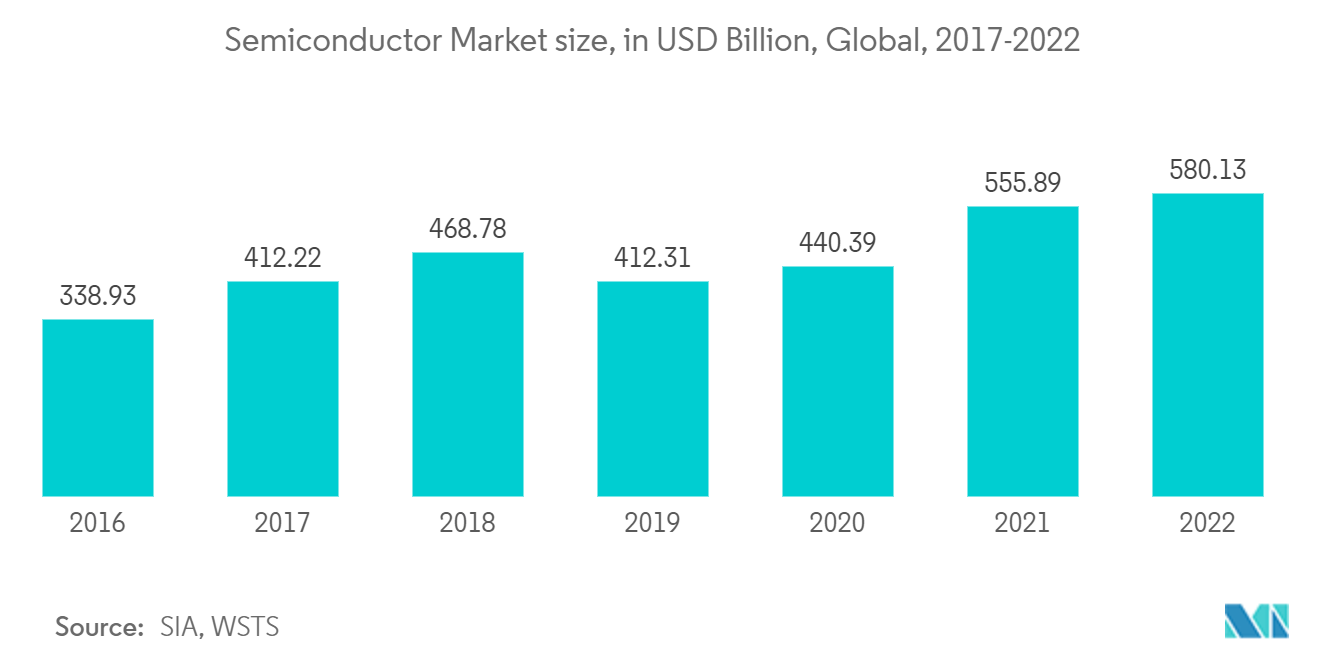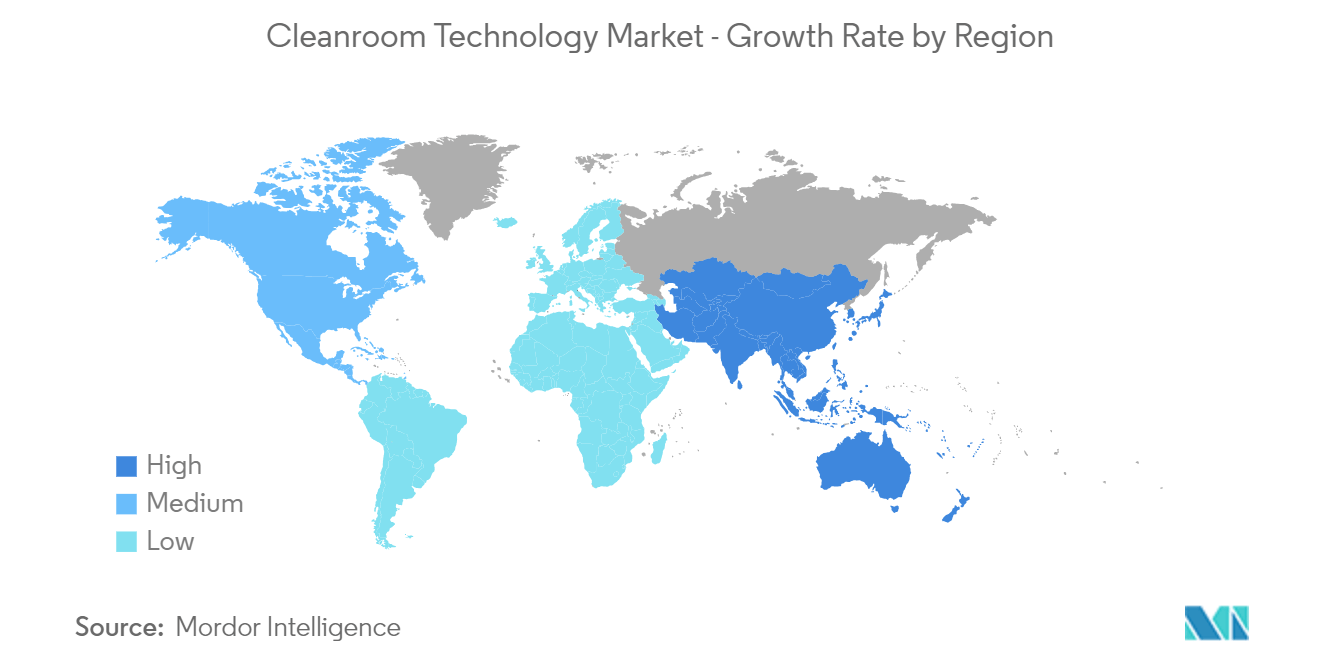Market Trends of Cleanroom Technology Industry
Semiconductor Manufacturing to be the Largest End User
- Cleanrooms are a necessary part of semiconductor manufacturing as this industry relies heavily on cleanroom environments to manufacture sensitive microelectronics. Semiconductor chips are utilized in every computerized device - from household objects like cell phones to complex machines such as vehicles, defense technology, or spacecraft. They are produced using highly sensitive materials to create delicate layers that must be worked on carefully. Thus, tasks like semiconductor chip manufacturing, testing, and packaging must be carried out in a controlled cleanroom environment.
- Semiconductor cleanrooms are amongst the most demanding cleanrooms. As photolithography linewidths go below 0.1 microns, these cleanrooms are usually class 10 or 100 cleanroom classification (ISO-4 or ISO-5). Additionally, semiconductor cleanrooms have tight temperature and humidity requirements. Such cleanrooms can vary in size from 500 SF to 500,000 SF; usually, semiconductor cleanrooms use ULPA filters instead of HEPA filters to prevent even the smallest submicron particles from entering the cleanroom. While HEPA filters can catch 99.97% of particles at 0.3u, ULPA filters can catch 99.999% at 0.12u.
- Owing to extremely fine linewidths, the manufacturing processes in semiconductor cleanrooms are highly sensitive to temperature and humidity variations. Typically, semiconductor cleanrooms need +1 degrees Fahrenheit and +5% or 10% relative humidity. This requires dedicated air handlers for each room with hot and cold elements. Most semiconductor cleanrooms have dedicated chillers and boilers to support the HVAC system. Furthermore, personnel working in semiconductor cleanrooms usually wear bunny suits, booties, hoods, masks, and gloves to prevent particles from entering the cleanroom. After garbing up, the personnel often pass through a cleanroom air shower, which blows them off with HEPA-filtered air to remove any particles on the outside of their cleanroom garments.
- Furthermore, the growing investments in the semiconductor industry around the world are a key growth driver for the market. For instance, in August 2022, the United States government passed the CHIPS and Science Act aimed at boosting semiconductor chip manufacturing in the country. It authorized around USD 52 billion in government subsidies for semiconductor manufacturing and research in the US and an estimated USD 24 billion in investment tax credits for semiconductor chip manufacturers.
- Due to this, the growing demand for nanotechnology and semiconductors necessitates implementing more sophisticated cleanroom procedures. Rensselaer Polytechnic Institute (RPI) provides the Micro and Nanofabrication Clean Room (MNCR) facility, housed within the Center for Materials, Devices, and Integrated Systems (CMDIS), which offers the BYOND program to undergraduate students seeking to establish a solid foundation and acquire training for a career in this field.
- With the semiconductor industry expanding significantly and its dominance in the APAC region, the region is expected to provide significant potential growth to the studied market. The first modern cleanroom facility globally can be dated back to the 1960s, and the cleanroom facility was introduced to developing Asia, including Malaysia, in the 1980s.
- Cleanroom shifted from the US to Asia in the 1990s due to the growth of semiconductor and microelectronics manufacturing industries. US companies such as Intel, Dell, Motorola, etc. established their manufacturing facilities in Asia during that period, which has driven the growth of the cleanroom industry in Asia.

North America is Expected to Hold Significant Market Share
- It is anticipated that North America will experience significant growth during the projected period, primarily due to the rising aftermarket sales and the shift towards modified cut-to-length logging techniques in the region.
- This growth is largely attributed to the growing biotechnology industry, which is still young, especially compared with the automotive, chemical, and steel industries. The growth of the biotechnology industry is a unique story, and yet it rests on foundations common to other segments of American industry.
- Years of research, both government-funded and privately funded, continue to provide a knowledge base unequaled in the world. Through biomanufacturing, sustainable biomass across the United States has been converted into new products and provides an alternative to petroleum-based production for chemicals, medicines, fuels, materials, and more.
- For instance, in September 2022, President Biden signed an Executive Order (EO) on 'Advancing Biotechnology and Biomanufacturing Innovation for a Sustainable, Safe, and Secure American Bioeconomy.' In the EO, the President laid out his vision for a whole-of-government approach to advance biotechnology and biomanufacturing by creating a research agenda that outlines the foundational and use-inspired R&D needs that will lead to innovative solutions in health, climate change, energy, food security, agriculture, supply chain resilience, and national and economic security.
- With the growing biotechnology sector, cleanroom technology has seen significant investment from the regional players. For instance, in November 2022, Charles River Laboratoires International, Inc. announced the expansion of its cell therapy contract development and manufacturing (CDMO) facility in Memphis, Tenn. The expanded space is suitable for clinical and commercial cell therapy manufacturing, with an additional nine (9) state-of-the-art processing suites, adding to 16 cleanrooms.
- Furthermore, the regional countries are largely looking forward to strengthening chip manufacturing, which is expected to help America with the strategic technologies of the future, including AI, 5G, quantum computing, and more, that will determine global economic and military leadership for decades to come. According to a new report by the Semiconductor Industry Association, the US government has a strategic opportunity to reverse the decades-long trajectory of declining chip manufacturing in America, strengthen national security, make supply chains more resilient, and make the country one of the most attractive places in the world to produce semiconductors. This growth is expected to provide a wide share of traction to the North American cleanroom technology market as the companies have announced their plans to majorize the region in the upcoming few years.

